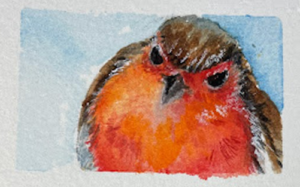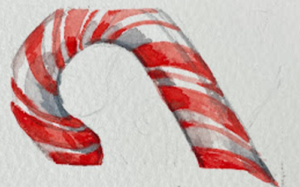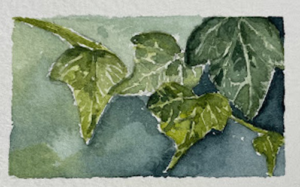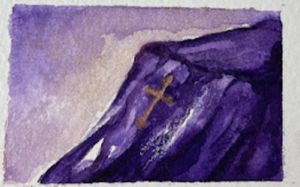
The Christmas period is festooned with bright and sparkling colours, but did you know each of the main traditional colours of Red, Green, White, Blue, Purple, Gold and Silver have their own symbolism originating from ancient customs, pagan rituals, Christian icons, or an amalgamation of different cultural traditions.
Here, Anita explores some of the main traditional Christmas Colours, their symbolism, and their meaning for the festive period.
This is a powerful colour which attracts attention and evokes passion and warmth in the colder winter months. It is one of the most iconic Christmas colours, with Santa Claus emblazoned with his bright red suit. Santa is a patchwork character constructed from different sources across cultures and time, from St Nicholas, a 4th-century bishop of Greek descent, the Dutch Sinterklaas, Kris Kringle – a corruption of the German word Christkindl (meaning Christ Child) and Father Christmas from English folklore, to become the iconic character represented today. The standard red suit is a modern representation of the gift-giving figure, largely attributed to the Coca-Cola Company’s advertising in the 1930s. Earlier incarnations have been depicted or described in a variety of colours including red but also tan or brown and often green.
In Christianity, the colour red is used to represent the Blood of Jesus which was shed for our salvation as he died on the cross. It is also a reflection of the colour of the Holly berries which flourish during the winter months. From the 13th century Red was a colour worn by Cardinals and senior clerics of the Roman Catholic church and St Nicholas, known for his generous worthy deeds and secret gift-giving is often portrayed in the Middle Ages as wearing the red cardinal robes.
In the popular traditional British Christmas carol “The Holly and the Ivy” the lyrics mention the red of the berries and their representation of the birth of Christ.
The holly bears a berry,
As red as any blood,
And Mary bore sweet Jesus Christ
For to do us sinners good.
 Strongly associated with the Christmas period the European Robin, with its bright red breast feathers, also has a starring role. According to different legends, the robin was originally a brown and white bird but was stained by the blood of Jesus as the bird sang a song to comfort Christ dying on the cross. In another story, the breast feathers were burnt on the fire which was being fanned to keep the baby Jesus warm. Similarly, the beautiful male Red Cardinal bird (or Northern Cardinal), a common bird across America with is bright red plumage is named after the red garments worn by cardinals of the Catholic Clergy. With a flash of red colour in the winter months, it has its own relationship with Christmas as it symbolises the Blood of Christ and can be seen decorating cards and trees across the continent.
Strongly associated with the Christmas period the European Robin, with its bright red breast feathers, also has a starring role. According to different legends, the robin was originally a brown and white bird but was stained by the blood of Jesus as the bird sang a song to comfort Christ dying on the cross. In another story, the breast feathers were burnt on the fire which was being fanned to keep the baby Jesus warm. Similarly, the beautiful male Red Cardinal bird (or Northern Cardinal), a common bird across America with is bright red plumage is named after the red garments worn by cardinals of the Catholic Clergy. With a flash of red colour in the winter months, it has its own relationship with Christmas as it symbolises the Blood of Christ and can be seen decorating cards and trees across the continent.
 Red is commonly used in combination with other colours, and these have their own significance and traditions. Take for example the red and white striped candy cane a popular peppermint sweet treat which is hung on the Christmas tree. Thought to have originated in Germany in the 17th century as a plain white confectionary straight candy stick which was shaped into a crook, symbolising the crooked staff used by shepherds for tending sheep and the J for Jesus. A nod to the shepherds who attended Jesus at his birth and Jesus often referred to as the “good shepherd” bringing lost lambs back to the fold. The red stripe was added in the later years and thought to represent Christ’s blood sacrifice entwined with the purity of the white.
Red is commonly used in combination with other colours, and these have their own significance and traditions. Take for example the red and white striped candy cane a popular peppermint sweet treat which is hung on the Christmas tree. Thought to have originated in Germany in the 17th century as a plain white confectionary straight candy stick which was shaped into a crook, symbolising the crooked staff used by shepherds for tending sheep and the J for Jesus. A nod to the shepherds who attended Jesus at his birth and Jesus often referred to as the “good shepherd” bringing lost lambs back to the fold. The red stripe was added in the later years and thought to represent Christ’s blood sacrifice entwined with the purity of the white.
 Red and Green is a quintessential Christmas colour combination, these complementary colours evident both in nature and throughout history. The hardy and enduring evergreen holly with its glossy green spiked leaves and the bright red berries are stand-out colours as they dominate in the cold winter months. Centuries ago, the Romans would celebrate Saturnalia in honour of Saturn, the god of agriculture and renewal on December 17th-25th. Wreaths of holly were woven and hung on walls and doors and tied sprigs were given as gifts. Revered by the ancient Celts this bright plant was used as a symbol of protection and prosperity in the winter months and winter celebrations. The symbolism of the Holly would be converted for Christian worship as it came to represent the crown of thorns placed on Jesus’ head at the crucifixion and the red berries as his blood. Red and green became common colours in religious iconography and paintings with the green being the ever-lasting life of Christ and the red the blood shed by Jesus on the cross.
Red and Green is a quintessential Christmas colour combination, these complementary colours evident both in nature and throughout history. The hardy and enduring evergreen holly with its glossy green spiked leaves and the bright red berries are stand-out colours as they dominate in the cold winter months. Centuries ago, the Romans would celebrate Saturnalia in honour of Saturn, the god of agriculture and renewal on December 17th-25th. Wreaths of holly were woven and hung on walls and doors and tied sprigs were given as gifts. Revered by the ancient Celts this bright plant was used as a symbol of protection and prosperity in the winter months and winter celebrations. The symbolism of the Holly would be converted for Christian worship as it came to represent the crown of thorns placed on Jesus’ head at the crucifixion and the red berries as his blood. Red and green became common colours in religious iconography and paintings with the green being the ever-lasting life of Christ and the red the blood shed by Jesus on the cross.
 The colour Green is a symbol of luck, prosperity, fertility and hope in the winter months when the evergreens dominate, plants like Yew, Ivy, Holly, Mistletoe and the evergreen Firs and Pine trees represent Christ’s everlasting life. For thousands of years, the colour green during winter has been revered and used for winter festivals by both pagans and Christians. Evergreen wreaths were used to decorate the home and it has become common practice to bring Christmas trees into the home to decorate.
The colour Green is a symbol of luck, prosperity, fertility and hope in the winter months when the evergreens dominate, plants like Yew, Ivy, Holly, Mistletoe and the evergreen Firs and Pine trees represent Christ’s everlasting life. For thousands of years, the colour green during winter has been revered and used for winter festivals by both pagans and Christians. Evergreen wreaths were used to decorate the home and it has become common practice to bring Christmas trees into the home to decorate.
 We dream of a white Christmas with clear white snow covering the ground during the festive period and white frost is common in the morning in the Northern Hemisphere. This is one of the reasons the colour white has associations with Christmas. In Christianity, white is a symbol of purity and peace, and white doves are common Christmas ornaments, white altar cloths are used at Christmas (and Easter time) to cover the altar in most churches.
We dream of a white Christmas with clear white snow covering the ground during the festive period and white frost is common in the morning in the Northern Hemisphere. This is one of the reasons the colour white has associations with Christmas. In Christianity, white is a symbol of purity and peace, and white doves are common Christmas ornaments, white altar cloths are used at Christmas (and Easter time) to cover the altar in most churches.
 In the early 19th century Carol, ‘The Holly, and the Ivy’ describes the white holly flower which represents Jesus’ birth and his purity.The holly bears a blossom,
In the early 19th century Carol, ‘The Holly, and the Ivy’ describes the white holly flower which represents Jesus’ birth and his purity.The holly bears a blossom,
As white as the lily flower,
And Mary bore sweet Jesus Christ,
To be our sweet Saviour.
 Sparkling and rich, luxurious and precious, the colour gold is linked to the Christmas story of the wise men or Magi presenting gold as one of the three gifts to the newborn Christ Child. Significant religious or historical icons are given a golden halo or bathed in gold being light and the rays of the sun, power, wealth, and prosperity. In the Russian Orthodox Church, a gold cloth is used to cover the altar at Christmas time rather than the white cloth used by other churches.
Sparkling and rich, luxurious and precious, the colour gold is linked to the Christmas story of the wise men or Magi presenting gold as one of the three gifts to the newborn Christ Child. Significant religious or historical icons are given a golden halo or bathed in gold being light and the rays of the sun, power, wealth, and prosperity. In the Russian Orthodox Church, a gold cloth is used to cover the altar at Christmas time rather than the white cloth used by other churches.
 Silver has been a valuable commodity for millennia and for Christians it symbolises the birth and divinity of Jesus. Silver stars and silver bells are common Christmas objects, and the sparkling of the snow can be represented with some silver glitter.
Silver has been a valuable commodity for millennia and for Christians it symbolises the birth and divinity of Jesus. Silver stars and silver bells are common Christmas objects, and the sparkling of the snow can be represented with some silver glitter.
 Colours in the church calendar are made up of seasons with liturgical colours that follow the life of Jesus. Purple is a deeply spiritual colour, beginning in December with Advent, the four-week period leading up to Christmas, purple represents the preparation for the birth of Jesus and is used for altar linen, clergy robes and various hangings. A highly sought-after dye, the colour purple has a very long history and evidence remains that 16,000 years ago in an area of France, a purple colour was created from a mix of manganese and hematite to decorate cave walls. Typically associated with royalty and the wealthy due to scarcity especially in the West and the investment needed in crushing thousands of shellfish for just a gram of purple dye. Jesus is described in the bible as a king or king of kings it is a colour used to represent Christ and his birth.
Colours in the church calendar are made up of seasons with liturgical colours that follow the life of Jesus. Purple is a deeply spiritual colour, beginning in December with Advent, the four-week period leading up to Christmas, purple represents the preparation for the birth of Jesus and is used for altar linen, clergy robes and various hangings. A highly sought-after dye, the colour purple has a very long history and evidence remains that 16,000 years ago in an area of France, a purple colour was created from a mix of manganese and hematite to decorate cave walls. Typically associated with royalty and the wealthy due to scarcity especially in the West and the investment needed in crushing thousands of shellfish for just a gram of purple dye. Jesus is described in the bible as a king or king of kings it is a colour used to represent Christ and his birth.
Book of Revelation 17:14
These will wage war against the Lamb, and the Lamb will overcome them because He is Lord of lords and King of kings, and those who are with Him are the called and chosen and faithful.
 Another expensive dye which only the rich could afford is blue which was only worn by important people as the pigments themselves were expensive and scarce dye only the rich could afford. A colour which is a sign of holiness in Christianity which is why Mary, Mother of Jesus is depicted as wearing blue. From the 16th Century Father Christmas, an English Folklore figure, originally a pagan figure, the Winter King cloaked in green and if you were kind to him, you would receive great things like a mild winter, and prosperous spring, before he became the recognised character we know today in his red and white attire, was often portrayed as wearing blue.
Another expensive dye which only the rich could afford is blue which was only worn by important people as the pigments themselves were expensive and scarce dye only the rich could afford. A colour which is a sign of holiness in Christianity which is why Mary, Mother of Jesus is depicted as wearing blue. From the 16th Century Father Christmas, an English Folklore figure, originally a pagan figure, the Winter King cloaked in green and if you were kind to him, you would receive great things like a mild winter, and prosperous spring, before he became the recognised character we know today in his red and white attire, was often portrayed as wearing blue.
These traditional colours have their roots in history and like the Christmas traditions have evolved and from ancient beliefs, religious traditions and from many different cultures and rituals.
Merry Christmas and a Happy New Year